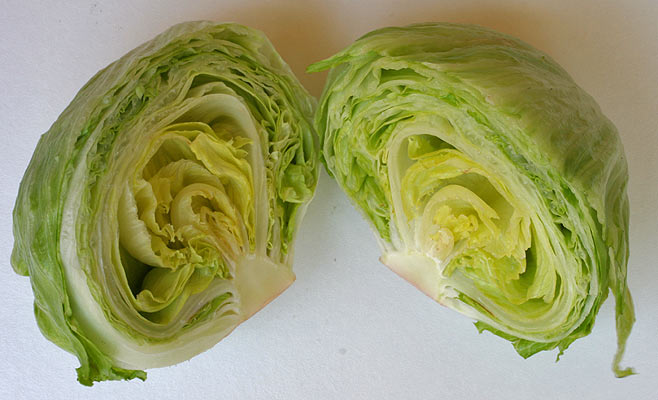|
Lactuca sativa (Lettuce)
Life
> eukaryotes >
Archaeoplastida >
Chloroplastida
>
Charophyta > Streptophytina > Plantae (land plants)
> Tracheophyta (vascular plants) > Euphyllophyta > Lignophyta (woody plants)
> Spermatophyta (seed plants) > Angiospermae (flowering
plants)
> Eudicotyledons > Core Eudicots > Asterids
> Euasterid II > Order:
Asterales > Family: Asteraceae > Tribe: Lactuceae
> Genus: Lactuca
 |
|
Lettuce. [photo H. Robertson, Iziko
©] |
Lettuce originates from the wild Lactuca serriola
found in the Mediterranean and Near East and has been transformed from an erect
plant with bitter leaves to various cultivars including ones with distinctive
heads of chlorophyll deficient leaves.
The name Lactuca sativa applies to the cultivated
lettuce which is thought to have been selectively bred from the wild, weedy Lactuca
serriola which grows around the Mediterranean and in the Near East. The wild
species of Lactuca do not form the distinctive heads of cultivated
lettuce and instead are erect, branched plants with bitter leaves containing a
milky latex. All lettuce cultivars such as Cos, Leaf, Butterhead and Iceberg are
regarded as being variants of Lactuca sativa. Paintings of what appear to
be Cos Lettuce have been found in Egyptian tombs dating back to as early as 4500
BC although there is some uncertainty about their identity. Cos Lettuce has
large seeds which are retained till after harvest and it is thought that the
Egyptians most likely grew lettuce for the seeds which contain an edible oil.
The first authenticated records of cultivated lettuce date back to Greek
historical records in 450 BC. In the first century AD the Romans were growing a
number of different cultivars. A large number of different cultivars of lettuce
have been bred and are now grown all over the World, mainly for use in salads.
References
-
Sauer, J.D. 1993. Historical geography of
crop plants - a select roster. CRC Press, Boca Raton, Florida.
Text by Hamish Robertson |
